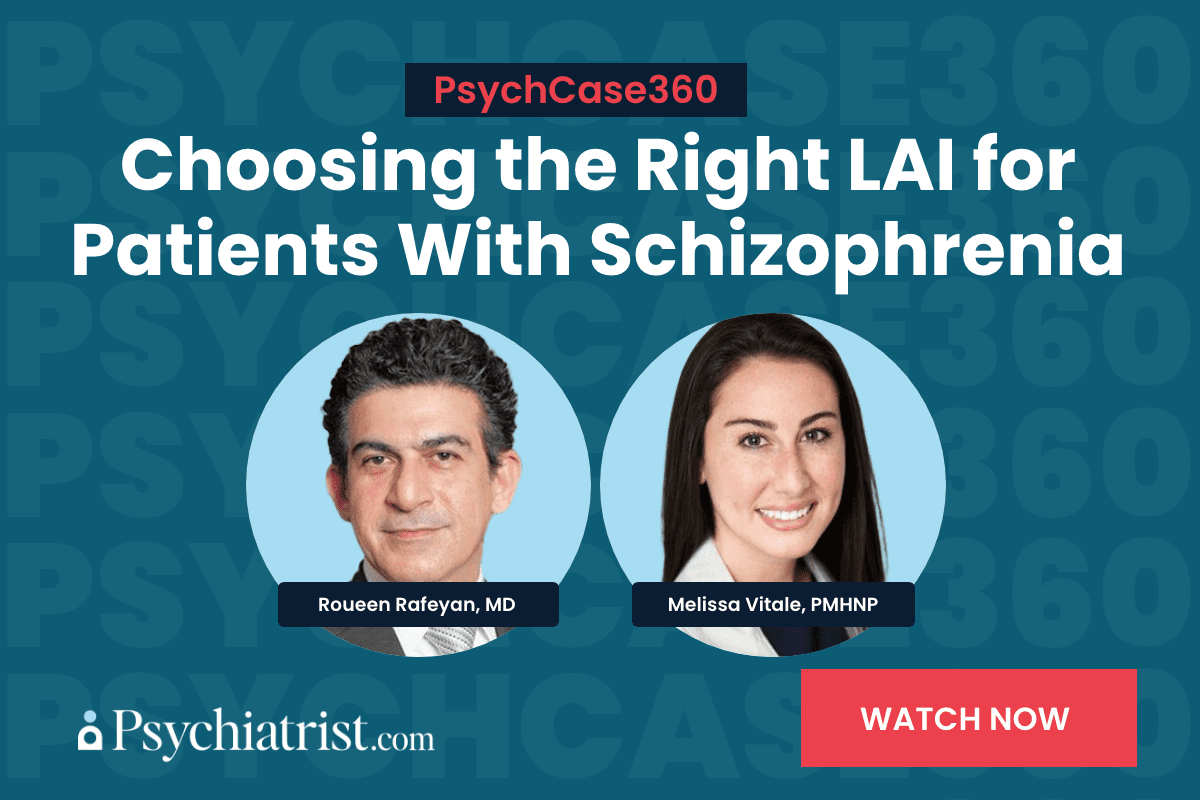ABSTRACT
Objective: Several promising studies investigated marine omega-3 fatty acids (ie, fish oil) in borderline personality disorder (BPD), but overall effects remain unclear. The aim of this study was to obtain estimates of effectiveness of omega-3 fatty acids in BPD using meta-analysis, with a priori differentiation of affective, impulsive, and cognitive-perceptual symptom domains.
Data Sources: We performed a literature search in PubMed, EMBASE, PsycINFO, and MEDLINE, using terms related to BPD and omega-3 fatty acids. Publication date was not a restriction.
Study Selection: We included randomized controlled trials (RCTs) that compared omega-3 fatty acids to placebo or any active comparator and pooled data using meta-analysis. Five studies were included in the meta-analysis, describing 4 RCTs testing effects of omega-3 fatty acids in 137 patients with BPD or BPD-related behavior.
Data Extraction: Using a pre-piloted data extraction form, we obtained data including intervention dose, duration, and BPD symptom scale scores, differentiating affective, impulsive, and cognitive-perceptual symptom domains.
Results: Random effects meta-analysis showed an overall significant decreasing effect of omega-3 fatty acids on overall BPD symptom severity (0.54 standardized difference in means [SDM]; 95% CI = 0.91 to 0.17; Z = 2.87; P = .0041), without heterogeneity (I2 = 0.00; Q = 2.63; P = .45). A priori differentiation of relevant symptom domains showed significant effects on affect dysregulation (0.74 SDM; 95% CI = 1.21 to 0.27; Z = 3.11; P = .002) and impulsive behavior (0.45 SDM; 95% CI = 0.84 to 0.059; Z = 2.26; P = .024). However, effects on cognitive-perceptual symptoms did not reach the significance threshold.
Conclusions: Available data indicate that marine omega-3 fatty acids improve symptoms of BPD, particularly impulsive behavioral dyscontrol and affective dysregulation. Marine omega-3 fatty acids could be considered as add-on therapy.
References (61)

- Bender DS, Skodol AE. Borderline personality as a self-other representational disturbance. J Pers Disord. 2007;21(5):500–517. PubMed CrossRef
- Pompili M, Girardi P, Ruberto A, et al. Suicide in borderline personality disorder: a meta-analysis. Nord J Psychiatry. 2005;59(5):319–324. PubMed CrossRef
- Hastrup LH, Jennum P, Ibsen R, et al. Societal costs of borderline personality disorders: a matched-controlled nationwide study of patients and spouses. Acta Psychiatr Scand. 2019;140(5):458–467. PubMed CrossRef
- National Collaborating Centre for Mental Health (UK). Borderline Personality Disorder: Treatment and Management. NICE Clinical Guidelines, No. 78. British Psychological Society; 2009.
- Ingenhoven T, Lafay P, Rinne T, et al. Effectiveness of pharmacotherapy for severe personality disorders: meta-analyses of randomized controlled trials. J Clin Psychiatry. 2010;71(1):14–25. PubMed CrossRef
- Soloff PH. Algorithms for pharmacological treatment of personality dimensions: symptom-specific treatments for cognitive-perceptual, affective, and impulsive-behavioral dysregulation. Bull Menninger Clin. 1998;62(2):195–214. PubMed
- Ingenhoven T. Pharmacotherapy for borderline patients: business as usual or by default? J Clin Psychiatry. 2015;76(4):e522–e523. PubMed CrossRef
- Drews E, Fertuck EA, Koenig J, et al. Hypothalamic-pituitary-adrenal axis functioning in borderline personality disorder: a meta-analysis. Neurosci Biobehav Rev. 2019;96:316–334. PubMed CrossRef
- Thomas N, Gurvich C, Hudaib A-R, et al. Systematic review and meta-analysis of basal cortisol levels in borderline personality disorder compared to non-psychiatric controls. Psychoneuroendocrinology. 2019;102:149–157. PubMed CrossRef
- Wingenfeld K, Dettenborn L, Kirschbaum C, et al. Reduced levels of the endocannabinoid arachidonylethanolamide (AEA) in hair in patients with borderline personality disorder—a pilot study. Stress. 2018;21(4):366–369. PubMed CrossRef
- Blaney C, Sommer J, El-Gabalawy R, et al; CIHR Team in Defining the Burden and Managing the Impact of Psychiatric Comorbidity in Immune-Mediated Inflammatory Disease. Incidence and temporal trends of co-occurring personality disorder diagnoses in immune-mediated inflammatory diseases. Epidemiol Psychiatr Sci. 2020;29:e84. PubMed CrossRef
- Díaz-Marsá M, Macdowell KS, Guemes I, et al. Activation of the cholinergic anti-inflammatory system in peripheral blood mononuclear cells from patients with borderline personality disorder. J Psychiatr Res. 2012;46(12):1610–1617. PubMed CrossRef
- MacDowell KS, Marsá MD, Buenache E, et al. Inflammatory and antioxidant pathway dysfunction in borderline personality disorder. Psychiatry Res. 2020;284:112782. PubMed CrossRef
- Anderson G. Pathoetiology and pathophysiology of borderline personality: role of prenatal factors, gut microbiome, mu- and kappa-opioid receptors in amygdala-PFC interactions. Prog Neuropsychopharmacol Biol Psychiatry. 2020;98:109782. PubMed CrossRef
- O’Neill A, Frodl T. Brain structure and function in borderline personality disorder. Brain Struct Funct. 2012;217(4):767–782. PubMed CrossRef
- Mocking RJT, Assies J, Ruhé HG, et al. Focus on fatty acids in the neurometabolic pathophysiology of psychiatric disorders. J Inherit Metab Dis. 2018;41(4):597–611. PubMed CrossRef
- Hibbeln JR, Linnoila M, Umhau JC, et al. Essential fatty acids predict metabolites of serotonin and dopamine in cerebrospinal fluid among healthy control subjects, and early- and late-onset alcoholics. Biol Psychiatry. 1998;44(4):235–242. PubMed CrossRef
- Pawełczyk T, Grancow-Grabka M, Trafalska E, et al. An increase in plasma brain derived neurotrophic factor levels is related to n-3 polyunsaturated fatty acid efficacy in first episode schizophrenia: secondary outcome analysis of the OFFER randomized clinical trial. Psychopharmacology (Berl). 2019;236(9):2811–2822. PubMed CrossRef
- Giacobbe J, Benoiton B, Zunszain P, et al. The anti-inflammatory role of omega-3 polyunsaturated fatty acids metabolites in pre-clinical models of psychiatric, neurodegenerative, and neurological disorders. Front Psychiatry. 2020;11:122. PubMed CrossRef
- Freeman MP, Hibbeln JR, Wisner KL, et al. Omega-3 fatty acids: evidence basis for treatment and future research in psychiatry. J Clin Psychiatry. 2006;67(12):1954–1967. PubMed CrossRef
- Assies J, Pouwer F, Lok A, et al. Plasma and erythrocyte fatty acid patterns in patients with recurrent depression: a matched case-control study. PLoS One. 2010;5(5):e10635. PubMed CrossRef
- Zaalberg A, Vanhouche, A-S, Smoyer A, et al. Voeding En Justitiabelen: Van Strafelement Naar Rehabilitatie-Instrument? Wetenschappelijk Onderzoek- en Documentatiecentrum; 2018.
- Individueel zorgplan en behandeling. In: Depressieve Stoornissen. GGZ Standaarden; 2018. https://www.ggzstandaarden.nl/zorgstandaarden/depressieve-stoornissen/individueel-zorgplan-en-behandeling
- Firth J, Teasdale SB, Allott K, et al. The efficacy and safety of nutrient supplements in the treatment of mental disorders: a meta-review of meta-analyses of randomized controlled trials. World Psychiatry. 2019;18(3):308–324. PubMed CrossRef
- Moher D, Liberati A, Tetzlaff J, et al; PRISMA Group. Preferred reporting items for systematic reviews and meta-analyses: the PRISMA statement. PLoS Med. 2009;6(7):e1000097. PubMed CrossRef
- Stoffers‐Winterling JM, Storebø OJ, Völlm BA, et al. Pharmacological interventions for people with borderline personality disorder. Cochrane Database Syst Rev. 2018(2):CD012956. CrossRef
- Mocking RJ, Harmsen I, Assies J, et al. Meta-analysis and meta-regression of omega-3 polyunsaturated fatty acid supplementation for major depressive disorder. Transl Psychiatry. 2016;6(3):e756. PubMed CrossRef
- Higgins JPT, Altman DG, Gøtzsche PC, et al; Cochrane Bias Methods Group; Cochrane Statistical Methods Group. The Cochrane Collaboration’s tool for assessing risk of bias in randomised trials. BMJ. 2011;343:d5928. PubMed CrossRef
- Guyatt GH, Oxman AD, Schünemann HJ, et al. GRADE guidelines: a new series of articles in The Journal of Clinical Epidemiology. J Clin Epidemiol. 2011;64(4):380–382. PubMed CrossRef
- Upton J. Beck Depression Inventory (BDI). In: Gellman MD, Turner JR, eds. Encyclopedia of Behavioral Medicine. Springer New York; 2013:178–179.
- Gonzalez JS, Shreck E, Batchelder A. Hamilton Rating Scale for Depression (HAM-D). In: Gellman MD, Turner JR, eds. Encyclopedia of Behavioral Medicine. Springer New York; 2013:887–888.
- Coccaro EF. The Overt Aggression Scale Modified (OAS-M) for clinical trials targeting impulsive aggression and intermittent explosive disorder: validity, reliability, and correlates. J Psychiatr Res. 2020;124:50–57. PubMed CrossRef
- Dougherty DM, Marsh DM, Mathias CW. Immediate and delayed memory tasks: a computerized behavioral measure of memory, attention, and impulsivity. Behav Res Methods Instrum Comput. 2002;34(3):391–398. PubMed CrossRef
- Hall RCW, Parks J. The modified global assessment of functioning scale: addendum. Psychosomatics. 1995;36(4):416–417. PubMed CrossRef
- Kay SR, Opler LA, Lindenmayer J-P. The Positive and Negative Syndrome Scale (PANSS): rationale and standardisation. Br J Psychiatry suppl. 1989;155(7):59–67. PubMed CrossRef
- Quilty LC, Robinson JJ, Rolland JP, et al. The structure of the Montgomery-Åsberg Depression Rating Scale over the course of treatment for depression. Int J Methods Psychiatr Res. 2013;22(3):175–184. PubMed CrossRef
- Giesen-Bloo JH, Wachters LM, Schouten E, et al. The Borderline Personality Disorder Severity Index-IV: psychometric evaluation and dimensional structure. Pers Individ Dif. 2010;49(2):136–141. CrossRef
- Maier W, Buller R, Philipp M, et al. The Hamilton Anxiety Scale: reliability, validity and sensitivity to change in anxiety and depressive disorders. J Affect Disord. 1988;14(1):61–68. PubMed CrossRef
- Reise SP, Moore TM, Sabb FW, et al. The Barratt Impulsiveness Scale-11: reassessment of its structure in a community sample. Psychol Assess. 2013;25(2):631–642. PubMed CrossRef
- Sansone RA, Wiederman MW, Sansone LA. The Self-Harm Inventory (SHI): development of a scale for identifying self-destructive behaviors and borderline personality disorder. J Clin Psychol. 1998;54(7):973–983. PubMed CrossRef
- Rybarczyk B. Social and Occupational Functioning Assessment Scale (SOFAS). In: Kreutzer JS, DeLuca J, Caplan B, eds. Encyclopedia of Clinical Neuropsychology. Springer New York; 2011:2313.
- Busner J, Targum SD. The clinical global impressions scale: applying a research tool in clinical practice. Psychiatry (Edgmont). 2007;4(7):28–37. PubMed
- Ingenhoven TJ, Duivenvoorden HJ. Differential effectiveness of antipsychotics in borderline personality disorder: meta-analyses of placebo-controlled, randomized clinical trials on symptomatic outcome domains. J Clin Psychopharmacol. 2011;31(4):489–496. PubMed CrossRef
- Zanarini MC, Frankenburg FR. omega-3 Fatty acid treatment of women with borderline personality disorder: a double-blind, placebo-controlled pilot study. Am J Psychiatry. 2003;160(1):167–169. PubMed CrossRef
- Bellino S, Bozzatello P, Rocca G, et al. Efficacy of omega-3 fatty acids in the treatment of borderline personality disorder: a study of the association with valproic acid. J Psychopharmacol. 2014;28(2):125–132. PubMed CrossRef
- Bozzatello P, Rocca P, Bellino S. Combination of omega-3 fatty acids and valproic acid in treatment of borderline personality disorder: a follow-up study. Clin Drug Investig. 2018;38(4):367–372. PubMed CrossRef
- Hallahan B, Hibbeln JR, Davis JM, et al. Omega-3 fatty acid supplementation in patients with recurrent self-harm: single-centre double-blind randomised controlled trial. Br J Psychiatry. 2007;190(2):118–122. PubMed CrossRef
- Amminger GP, Chanen AM, Ohmann S, et al. Omega-3 fatty acid supplementation in adolescents with borderline personality disorder and ultra-high risk criteria for psychosis: a post hoc subgroup analysis of a double-blind, randomized controlled trial. Can J Psychiatry. 2013;58(7):402–408. PubMed CrossRef
- Buydens-Branchey L, Branchey M. Long-chain n-3 polyunsaturated fatty acids decrease feelings of anger in substance abusers. Psychiatry Res. 2008;157(1–3):95–104. PubMed CrossRef
- Long SJ, Benton D. A double-blind trial of the effect of docosahexaenoic acid and vitamin and mineral supplementation on aggression, impulsivity, and stress. Hum Psychopharmacol. 2013;28(3):238–247. PubMed CrossRef
- Mocking RJT, Steijn K, Roos C, et al. Omega-3 fatty acid supplementation for perinatal depression: a meta-analysis. J Clin Psychiatry. 2020;81(5):19r13106. PubMed CrossRef
- Sutin AR, Milaneschi Y, Cannas A, et al. Impulsivity-related traits are associated with higher white blood cell counts. J Behav Med. 2012;35(6):616–623. PubMed CrossRef
- Sutin AR, Terracciano A, Deiana B, et al. High neuroticism and low conscientiousness are associated with interleukin-6. Psychol Med. 2010;40(9):1485–1493. PubMed CrossRef
- Suchankova P, Holm G, Träskman-Bendz L, et al. The +1444C>T polymorphism in the CRP gene: a study on personality traits and suicidal behaviour. Psychiatr Genet. 2013;23(2):70–76. PubMed CrossRef
- Peet M, Brind J, Ramchand CN, et al. Two double-blind placebo-controlled pilot studies of eicosapentaenoic acid in the treatment of schizophrenia. Schizophr Res. 2001;49(3):243–251. PubMed CrossRef
- Jamilian H, Solhi H, Jamilian M. Randomized, placebo-controlled clinical trial of omega-3 as supplemental treatment in schizophrenia. Glob J Health Sci. 2014;6(7 spec no):103–108. PubMed
- Roberts DJ, Goralski KB. A critical overview of the influence of inflammation and infection on P-glycoprotein expression and activity in the brain. Expert Opin Drug Metab Toxicol. 2008;4(10):1245–1264. PubMed CrossRef
- Wongrattanakamon P, Lee VS, Nimmanpipug P, et al. Nucleotide-binding domain 1 modelling: a novel molecular docking approach for screening of P-glycoprotein inhibitory activity of bioflavonoids. Chemical Data Collections. 2016;2:10–16. CrossRef
- Mollazadeh S, Sahebkar A, Hadizadeh F, et al. Structural and functional aspects of P-glycoprotein and its inhibitors. Life Sci. 2018;214:118–123. PubMed CrossRef
- Wang JS, Taylor R, Ruan Y, et al. Olanzapine penetration into brain is greater in transgenic Abcb1a P-glycoprotein-deficient mice than FVB1 (wild-type) animals. Neuropsychopharmacology. 2004;29(3):551–557. PubMed CrossRef
- El Ela AA, Härtter S, Schmitt U, et al. Identification of P-glycoprotein substrates and inhibitors among psychoactive compounds—implications for pharmacokinetics of selected substrates. J Pharm Pharmacol. 2004;56(8):967–975. PubMed CrossRef
Enjoy this premium PDF as part of your membership benefits!
Save
Cite

